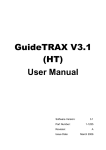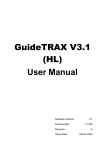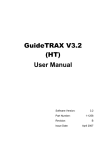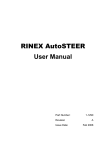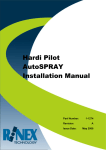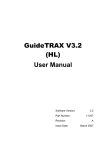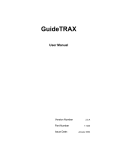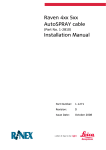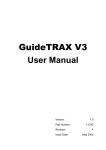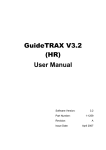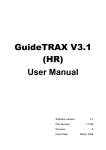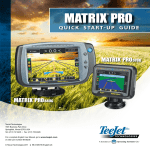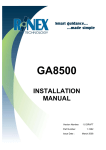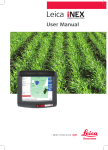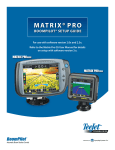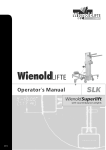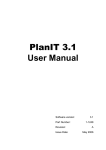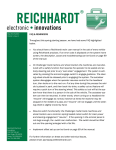Download GuideTRAX User Manual
Transcript
GuideTRAX User Manual Version: Part Number: Issue Date: Rev 2.1 1-1240 December 2004 Copyright Notice All rights reserved. No part of this publication may be reproduced, stored in a retrieval system, or transmitted in any form or by any means, electronic, mechanical photocopying, recording, or otherwise, without the prior written permission of Rinex Technology. Disclaimer No liability is assumed with respect to the use of the information contained herein. While every precaution has been taken in the preparation of this publication, RINEX assumes no responsibility for errors or omissions, no is any liability assumed for damages resulting from the use of the information contained herein. Further this publication and features described herein are subject to change without notice. Use of this system is strictly limited to providing steering assistance to the operator who must remain in control of the vehicle at all times. RINEX, including its officers servants and agents, does not make any representation to any party and will not accept any responsibility or liability whatsoever for any loss or damage of whatever nature suffered by any such person or corporation choosing or seeking to use this system or any part thereof. By use of this system you agree that RINEX is not liable or responsible for any damage whatsoever to the vehicle, any property, personal injuries, or death that may result from the use or abuse of this system. GuideTRAX User Manual Written for GuideTRAX PC software Version 2.1 Publication Date, October 2004 Copyright © 2004 by Rinex Technology. All rights reserved. Acknowledgements Windows 98®, Windows CE®, Windows XP®, and Wordpad are registered to Microsoft Corp. Other products and trademarks mentioned in this manual are the property of their registered owners. RINEX TECHNOLOGY ABN: 30 029 441 181 Office Location : 19 Lyall Street South Perth WA 6151 Postal Address : 19 Lyall Street South Perth WA 6151 Telephone : Local : International : (08) 9474 4771 +61-8-9474 4771 Facsimile : Local : International : (08) 9474 4772 +61-8-9474 4772 Internet : http://www.rinex.com.au Email : [email protected] RINEX LIMITED WARRANTY Products This warranty covers all products (the “Products”) manufactured and or sold by RINEX Technology or their authorised dealers. RINEX Technology Limited Warranty RINEX Technology (“RINEX”) hereby warrants solely to the end purchaser of the Products, subject to the exclusions and procedures set forth herein below, that the Products sold to such end purchaser shall be free, under normal use and maintenance, from defects in material and workmanship for a period of 12 months from delivery. Repairs and replacement components are warranted, subject to the exclusions and procedures set forth below, to be free, under normal use and maintenance, from defects in material and workmanship for 90 days from delivery, or for the balance of the original warranty period, whichever is greater. Purchaser’s Exclusive Remedy The end purchaser’s exclusive remedy under this warranty shall be limited to the repair or replacement, at the option of RINEX, of any defective Products or components thereof. The end user shall notify RINEX or a RINEX authorised dealer immediately of any claimed defect. Repairs shall be made through RINEX only. Exclusions RINEX does not warrant damage occurring in transit or due to misuse, abuse, improper installation, neglect, alteration, abnormal use, lightning (or other electrical discharge), exposure to moisture or dampness, excessive temperatures, spill of liquids or fluids, or acts of God. Repair, modification or service of RINEX products by any party other than an authorised RINEX dealer shall render this warranty null and void. RINEX does not warrant any Product where the Product serial number or nameplate has been removed, defaced or altered. RINEX does not warrant claims asserted after the end of the warranty period. RINEX does not warrant or guarantee the precision or accuracy of positions obtained when using Products. The potential accuracy of Products as stated in RINEX literature and/or Product specifications serves to provide only an estimate of achievable accuracy based on: • Specifications provided by the US Department of Defense for GPS Positioning, • GPS OEM Receiver specifications of the appropriate manufacturer (if applicable), and • DGPS service provider performance specifications. RINEX reserves the right to modify Products without any obligation to notify, supply or install any improvements or alterations to existing Products. No Other Warranties The foregoing warranty is exclusive of all warranties, whether written, oral, implied or arising by statute, course of dealing or trade usage, in connection with the design, sale, installation, service or use of any products or any components thereof, including, but not limited to, any warranty of merchantability or fitness for a particular purpose. Limitation of Liability The extent of RINEX’S liability for damages of any nature to the end purchaser or any other person or entity whether in contract or tort and whether to persons or property shall in no case exceed, in the aggregate, the cost of correcting the defect in the Product or, at RINEX’S option, the cost of replacing the defective item. In no event will RINEX be liable for any loss of production, loss of profits, loss of use for any special, indirect, incidental, consequential or contingent damages, even if RINEX has been advised of the possibility of such damages. Without limiting the foregoing, RINEX shall not be liable for any damages of any kind resulting from installation, use, quality, performance or accuracy of any products. RINEX LIMITED WARRANTY Governing Legislation To the greatest extent possible, this warranty shall be governed by the laws of the State of Western Australia. In the event that any provision hereof is held to be invalid by a court of competent jurisdiction, such provision shall be severed from this warranty and the remaining provisions shall remain in full force and effect. Obtaining Warranty Service In order to obtain warranty service, the end purchaser must bring the Product to an authorised RINEX dealer along with the end purchaser’s proof of purchase. The end purchaser must produce the original invoice or other purchase documents as proof of the purchase date. The end purchaser is solely responsible for the cost of transportation of the Product to RINEX or an authorised RINEX dealer and the Product is at the end purchaser's risk whilst in transit. For any questions regarding warranty service or to obtain information regarding the location of any of RINEX’s approved dealers, contact RINEX at the following address: Rinex Technology 19 Lyall Street South Perth Western Australia 6151 Telephone : (08) 9474 4771 Facsimile : (08) 9474 4772 Internet : www.rinex.com.au TABLE OF CONTENTS Table of Contents 1 Introduction .......................................................................................1 1.1 1.2 The Saturn “H” series ..................................................................................... 3 The Saturn “G” series ..................................................................................... 4 2 Getting Started ..................................................................................6 2.1 Powering the System...................................................................................... 9 2.1.1 Saturn “H” ................................................................................................. 9 2.1.2 Saturn “G”............................................................................................... 10 2.2 First Use Setup ............................................................................................. 11 2.3 The GPS Status............................................................................................ 13 2.4 The Load Process......................................................................................... 14 3 Using Guidance ...............................................................................16 3.1 3.2 3.3 3.4 Parallel Guidance ......................................................................................... 20 Racetrack (Lock) Guidance .......................................................................... 22 Contour Lines Method .................................................................................. 24 The External Lightbar (optional item)............................................................ 26 4 The Main Screen..............................................................................28 4.1 4.2 4.3 4.4 4.5 4.6 4.7 The Main Screen .......................................................................................... 31 Map Screen .................................................................................................. 33 Virtual Road Window .................................................................................... 36 Status Bar..................................................................................................... 38 GPS Status Indicator .................................................................................... 40 AutoSTEER Status Button............................................................................ 41 GPS Info ....................................................................................................... 42 5 The Menu System............................................................................44 5.1 Menu Layout................................................................................................. 47 5.2 The Main Menu............................................................................................. 48 5.3 The View Menu............................................................................................. 49 5.4 Field Menu.................................................................................................... 51 5.4.1 Memory................................................................................................... 52 5.4.2 The Files Menu ....................................................................................... 53 5.4.3 Restart Field ........................................................................................... 57 5.5 The Guide Menu ........................................................................................... 60 5.5.1 Guideline Offset ...................................................................................... 62 5.6 The Setup Menu ........................................................................................... 64 5.6.1 Lightbar................................................................................................... 65 5.6.2 General Setup......................................................................................... 67 5.6.3 Buttons Setup ......................................................................................... 76 5.6.4 About GuideTRAX .................................................................................. 78 TABLE OF CONTENTS 6 The Launcher...................................................................................80 6.1 Opening the Launcher .................................................................................. 83 6.1.1 Saturn “H” series..................................................................................... 83 6.1.2 Saturn “G” series .................................................................................... 83 6.2 Using the Launcher....................................................................................... 85 6.2.1 Launcher Main Window .......................................................................... 86 6.2.2 Reset Options ......................................................................................... 87 6.2.3 Utilities .................................................................................................... 88 7 Multiple Boom Section Interface....................................................90 8 AutoSPRAY......................................................................................94 8.1 Using AutoSPRAY ........................................................................................ 97 8.1.1 Enabling the AutoSPRAY Option............................................................ 97 8.2 AutoSPRAY Settings .................................................................................... 99 8.3 Viewing the Overlapped Areas ....................................................................101 8.4 Viewing the Percentage Overlap .................................................................102 9 AutoSTEER ....................................................................................104 9.1 9.2 9.3 9.4 9.5 9.6 9.7 9.8 9.9 Connecting the AutoSTEER Controller........................................................107 Enabling AutoSTEER ..................................................................................108 AutoSTEER Settings ...................................................................................109 The AutoSTEER Status Button....................................................................112 The AutoSTEER Status Window .................................................................114 The AutoSTEER Status Bar ........................................................................115 Setting the Guide Points ..............................................................................116 Activating AutoSTEER.................................................................................117 Deactivating AutoSTEER.............................................................................118 Appendix .............................................................................................120 A.1 Glossary ......................................................................................................121 A.2 Warning Messages ......................................................................................125 A.3 General Problems........................................................................................128 A.4 AutoSTEER Messages ................................................................................130 1 Introduction The GuideTRAX software has been developed by RINEX to maximize the advantages of today’s low cost computer technology with the benefits of accurate GPS technology. GPS guidance systems allow agricultural machinery to be far more productive by providing accurate and real time information for vehicle navigation and placement of product. Specifically the Saturn guidance systems provide an easy to use interface through the colour touch screen for vehicle guidance. The system may be used for any agricultural task which requires vehicle navigation, particularly for applications or treatment of chemicals and/or fertilisers and seeds. Treated areas can be seen on the screen as the vehicle is working, providing a continuous guidance display with area information. The Saturn guidance system records the information until it is manually cleared so operations can be interrupted if necessary, then returned to for completion. Different fields require different driving techniques and patterns. The GuideTRAX software supports many different patterns for guidance and allows for the easy change of the guidance pattern while on the move. This manual is designed to assist users of the Saturn guidance systems in the operational use of the GuideTRAX v2.1 software. Page 2 1.1 The Saturn “H” series RINEX manufacture a variety of guidance and control systems, including the Saturn series of guidance systems. The GuideTRAX v2.1 (version 2.1) software was designed specifically to operate on the Saturn “H” series which incorporates an intelligent power supply with an embedded Windows® operating system. The Saturn “H” series guidance systems automatically control the power position according to the vehicle ignition status which means that the guidance system is operational when the vehicle is running and inactive (OFF) when the vehicle is shutdown. The Saturn “H” series can be easily identified by its compact interface box as shown in Figure 1.1 Figure 1-1: The Saturn “H” interface box The physical properties of the Saturn “H” series interface box are as follows 230 (w) x 65 (h) x 190 (d) 1200gm Page 3 1.2 The Saturn “G” series The predecessor to the Saturn “H” series was the “G” series which incorporated different physical functionality. The GuideTRAX v2.1 (version 2.1) software has been adapted to operate on the “G” series with some slight differences which will be denoted in this manual as necessary. Primarily the only difference that the user will note is the powering of the system. Whereas the “H” series incorporated the intelligent power supply which senses the status of the vehicle ignition, the “G” series must be manually switched ON and OFF. The Saturn “G” series interface box as shown in Figure 1.2 Figure 1-2: The Saturn “G” interface box The physical properties of the Saturn “H” series interface box are as follows 230 (w) x 65 (h) x 300 (d) 4300gm Page 4 Page 5 2 Getting Started This section details the steps taken for the first time user of the overall system. In particular this section describes the correct way in which to power the system ON and OFF for both the Saturn “H” and “G” systems as they are different between the two models. Furthermore this section describes the necessary information, which includes measurements on the vehicle to ensure that the guidance system will display the correct information to the operator. Page 8 2.1 Powering the System Prior to starting with this manual the guidance system should be completely installed into the vehicle in accordance with the instructions with the installation manual. 2.1.1 Saturn “H” 1. Turn the Isolation Power Switch (IPS) on the Interface Box to the ON position (-). This will not immediately power the system as the vehicle ignition must also be ON. See Figure 2-1 to locate the IPS. 2. With the IPS on the Interface Box in the ON position, start the vehicle and leave the engine running. The Saturn guidance system will start to power on after a short period and the GuideTRAX software will be started. ISOLATION POWER SWITCH Figure 2-1 : The Saturn “H” interface box & IPS In normal operation, leave the Isolation Power Switch (IPS) on the Interface Box in the ON position (-) at all times. 3. To shut the Saturn “H” system OFF, simply turn the vehicle ignition off. This will shutdown the GuideTRAX software and power down the Saturn “H” system. The IPS should not be switched to the OFF position. Hints and Tips: There is no Exit button in the GuideTRAX v2.1 software. Do not turn the system off by turning the IPS OFF on the interface box. Shutting down the system off in this way may cause the loss of important system information. Page 9 2.1.2 Saturn “G” 1. With the power switch on the interface box in the OFF position start the vehicle. 2. Start the Saturn “G” by turning the power switch to ON position. Note that the system will not start immediately but will commence the startup procedure which takes approximately 120seconds to complete. The system will start and the GuideTRAX software will be ready for use. 3. To shutdown the Saturn “G” system the power switch should be turned OFF. The system will not power down immediately, but will start the process to shutdown the system which takes approximately 30 seconds to finish. For normal circumstances the vehicle should not be started with the Saturn “G” system running. Hints and Tips: There is no Exit button in the GuideTRAX v2.1 software. The system is turned off directly at the power switch on the interface box. This is different to the Saturn “H” system. Page 10 2.2 First Use Setup The following is a list of various settings that must be set for the GuideTRAX software to operate correctly according to a specific vehicle configuration. Set the vehicle swath: 1. From the Main Menu, touch on the Field button then touch on the Restart button. 2. From the Restart window, touch on the Swath button. 3. In the Boom Settings window, enter the correct boom settings. 4. See sections 5.4.3 for further assistance. Enter the link settings: 1. From the Main Menu, touch on the Setup button then touch on the Settings button. 2. From the General Setup window, touch on the Vehicle button. 3. From the Vehicle Setup window, touch on the Link Settings button. 4. In the Link Settings window, enter the correct link settings for the vehicle. 5. See section 5.6.2 for further assistance. Set the antenna offsets: 1. From the Main Menu, touch on the Setup button then touch on the Settings button. 2. From the General Setup window, touch on the Vehicle button. 3. In the Vehicle Setup window, touch on the Crosstrack value button. This will open the Numerical Keyboard window and a Crosstrack value can be entered. The Crosstrack value is the distance from the centre of the vehicle to the antenna. 4. Touch on the Steer value button. This will open the Numerical Keyboard window and a Steer value can be entered. The Steer value is the distance from the front of the vehicle to the antenna. 5. See sections 5.6.2 for further assistance. Set the Master and Section control: 1. From the Main Menu, touch on the Setup button then touch on the Settings button. 2. From the General Setup window, touch on the Comms button. Page 11 3. In the Comms Setup window, select the master control by touching the dot next to the correct option. 4. Now select the section control by touching the dot next to the correct option. 5. See section 5.6.2 for further assistance on the correct options to choose. Page 12 2.3 The GPS Status While the GuideTRAX software is starting, the GPS receiver may need some time before being fully operational. While this process is occurring the GPS Status Indicator may show a warning message (See section 4.5 for more details). When the GPS Status Icon changes to the scrolling satellite, the receiver is ready for normal operation. If the system has not been used recently, the GPS Status indicator may show a warning message for up to 15 minutes while the GPS receiver gathers new information about the visible satellites. Figure 2-1: The GPS Status Indicator Page 13 2.4 The Load Process When GuideTRAX is started, all treatment data in the field that was in use the last time the system was shutdown will be loaded and displayed on the map screen. Whenever GuideTRAX is in the process of loading treatment data, the progress window will be displayed. Figure 2-2: The Progress Window On completion of the loading of field data, the progress window will disappear automatically leaving the map screen in view. The system is then ready to commence working. Hints and Tips: When loading large fields, the loading process may be stopped by pressing the cancel button on the progress window if the field is not required. The field must then be restarted if it is to be used for a new treatment (See section 5.4.3 for more details on restarting the field). Page 14 Page 15 3 Using Guidance A major feature of GuideTRAX is the ability to provide guidance to the operator so that treatment can be applied to a field in as accurately as possible. In order to treat an entire field the operator will want to ensure that no areas are missed and minimize over lapping sprayed areas. Due to the never-ending shapes of fields a number of different spraying techniques have been adopted. These techniques, as shown in Figure 3-1 are summarised as follows. Parallel lines Perfectly straight lines that are parallel to each other. Racetrack Lines that are in an ever decreasing shape. The pattern is not necessarily a square or circle. Contour lines Lines that are parallel, however they are not straight. These lines are typically found around contour banks. Figure 3-1: Typical Spray patterns used in fields – Parallel Lines, Racetrack and Contour lines. It is not the intention of the GuideTRAX software to decide which method is superior as each operator has their own preferences as to which method they use for a given field. More importantly, it should be noted that the operator could use any of these techniques, or a combination, for guidance in applying a treatment to a field. Guidance is provided to the operator using the map screen, the virtual road window and the external light bar. Each device presents information to the operator that enables them to make decisions on which direction to travel. Page 18 The map screen provides a bird’s eye view of the treated area. The map view clearly shows where the vehicle is and the direction it is heading. The spray trail shows which areas have been treated and the area yet to be treated. A typical map screen with spray trail is shown in Figure 4-2. Alternatively, the map screen display can be split to show both the bird's eye view and the Virtual Road window, which projects the view forward at an angle of 45 degrees, and includes guidelines to show the projected path. An example is shown in Figure 4-3. Page 19 3.1 Parallel Guidance Spraying a field using the parallel method is very simple. As previously described, the parallel method is for straight lines only and consequently the first task is to set out a straight line to work from. This is easily achieved by defining one point at one end of the field and one at the other end and connecting the two points with a line. This is termed either the base or key line. From this line, the next parallel guideline is calculated to be across one swath width minus any guide overlap distance entered (See section 5.6.2 on guide overlap). GuideTRAX automatically calculates these parallel guidelines as the vehicle moves around the field. A typical parallel spray pattern is shown in Figure 3-2. Figure 3-2: A typical spray pattern using parallel guidance. Points “A” and “B” define the base line for all other parallel lines. The points “A” and “B” should be as far apart as practical to minimise errors in determining the base line. Ideally, the points should be located prior to commencing spraying so that the actual spray pattern along the base line is truly straight. Once the base line is defined, the operator simply needs to follow the indicators on the light bar to stay on-line. As one swath line is finished and the spray boom is turned off to turn back to start the next pass GuideTRAX will automatically increment to the next parallel line. Swath lines can be sprayed in any order and GuideTRAX will show the nearest parallel line to the vehicle. Swath lines will not be missed, as the treated area on the map screen will always show exactly which areas have been treated and the areas that haven’t. In order to use parallel line guidance, press the Point A button on the Guide Menu. A dot will appear on the screen representing point A. The Point A button will now turn into the Point B button. Once pressed it will create the second dot on the screen. The Point B button will now turn Page 20 into the Parallel Button. Press the parallel buttons to draw the projected parallel line and activate parallel guidance. The parallel guidance can be deleted/deactivated on this line by touching the Guide Off button or press Point A to redefine a new line (The system will prompt whether to create a new point A or cancel). Figure 3-3: Parallel guidance Page 21 3.2 Racetrack (Lock) Guidance The racetrack guidance method is called lock guidance because instead of using a pre-defined line, the system 'locks' on to previous swath run when calculating the guideline for the next run. This method of guidance is also very simple. The operator merely has to drive around the perimeter of the field as normally undertaken. Typically the outside perimeter would be governed by a fence line that dictates the shape of the field, this may be rectangular or some irregular shape. This is not important to GuideTRAX, as the next swath line will be adjacent to the last swath by the distance of one swath width minus any guide overlap distance (See section 5.6.2 on guide overlap). Once again, this is not important as GuideTRAX automatically calculates this for the operator. A typical racetrack spray pattern is shown in Figure 3-4. Figure 3-4: Typical Spray pattern using racetrack Once the perimeter of the field is completed the vehicle moves towards the next swath line using the map screen for guidance. When the vehicle comes alongside the previous treatment (perimeter lap) the operator touches the Lock button in the Guide Menu and then follows the Virtual Road or arrows on the light bar to stay on-line. A guideline is displayed on the map screen which indicates the line that needs to be followed. GuideTRAX will continue to automatically update the guideline as the vehicle moves around the field. The guideline will always be computed to be adjacent to the previous treatment. Hence, if the vehicle manoeuvres around a tree the subsequent guideline will also show a deviation. The operator can choose to ignore this guideline and simply steer straight through these areas. A typical racetrack screen is shown in Figure 3-5. Page 22 Figure 3-5: Typical guideline from racetrack guide lock Page 23 3.3 Contour Lines Method A contour line is a set of parallel lines that are not straight; however the adjacent lines are parallel to each other. The contour lines method is the same in operation as the racetrack method for spraying a field. The Guidance Lock button is used to lock on to an adjacent line, which is the contour line to be followed. The operator merely has to drive the first contour line in a field as normal. Typically, this will be alongside a contour bank that dictates the pattern or shape of the contour line to be followed. Similar to before, GuideTRAX computes the next guideline to be adjacent to the last swath by the distance of one swath width minus any guide overlap distance (See section 5.6.2 on guide overlap). Once again, this is not important as GuideTRAX automatically calculates this for the operator. A typical contour spray pattern is shown in Figure 3-6. Figure 3-6: Typical Spray pattern using contour lines As the first contour swath line is completed, the vehicle turns around to commence the next swath line using the map screen for guidance. Once the vehicle comes alongside the previous swath line (first contour line) the operator engages the guidance lock by pressing the Lock button in the Guide Menu and then follows the indicators on the light bar to stay on-line. A guideline is displayed on the map screen indicating the lock line that needs to be followed. At the end of the contour line, the guidance is switched off as the vehicle moves away from the treatment. Then as the vehicle is turned around to commence the next contour swath line the guidance lock is once again engaged by pressing the Lock button. This pattern is repeated until the field treatment has been completed. Page 24 As with the racetrack guidance, the guideline will always be computed to be adjacent to the last swath line. As shown previously if the vehicle manoeuvres around a tree or some other feature the next guideline will show the same pattern. Page 25 3.4 The External Lightbar (optional item) The external lightbar, an optional item, provides the driver with guidance information from a physical device that is mounted in the driver's line of vision. Changes of direction are easily seen, without having to look away from the driving task at hand. The lightbar provides a left-right indicator showing which way the operator must steer to get on to the current guideline. The operator simply manoeuvres the vehicle to either the left or right as indicated by the lightbar until the vehicle is on-line. A typical light bar display is shown in Figure 3-7. Figure 3-7: The lightbar display showing the vehicle is on-line. If the vehicle veers off-line, the lightbar will display arrows indicating the direction (left or right) needed to steer to the current guideline. The number of arrows shows how far off-track the vehicle is, determined by preset distances (See section 5.6.1 for details on how to define the lightbar offsets). If the vehicle travels further away than these distances, the display will show how many metres/feet the vehicle is away from the guideline. Figure 3-8: The lightbar display showing the vehicle is between 2 and 3 metres to the left of the guideline. (Note: Distance depends on lightbar settings) Figure 3-9: The lightbar display showing the vehicle is 5 metres offline. Page 26 Page 27 4 The Main Screen The GuideTRAX software operates on colour touch screen. Hence to access any function on the system it is a simple case of touching or tapping the screen on the appropriate button. The RINEX screen is a 22cm (diagonal measurement), or an optional 27cm, which should be securely attached to the vehicle in accordance with the installation manual. This section describes the various parts of the screen that both displays and allows the user to enter information into the system. Understanding the terminology of the various parts of the screen is important as the manual refers to these sections when describing the functions of the guidance system. Page 30 4.1 The Main Screen Menu Buttons Virtual Road Window Map Screen Status Bar Boom section Status AutoSTEER Status Figure 4-1: The Main Screen Page 31 GPS Status Overview: Item The main screen displays the following information. Description Map Screen The Map Screen occupies the greater part of the overall screen to display a number of items including the Vehicle Icon, treated area, guideline and the grid. See section 4.2 for more details. Virtual Road Window The Virtual Road Window, on the left of the overall screen displays the current guideline and the Virtual Road. See section 4.2 for more details. Status Bar The Status Bar is located at the bottom of the main screen and is used to display status information on the system. See section 4.4 for more details. GPS Status The GPS Status Indicator is used to display the current GPS status. Touching on the GPS status indicator will display the GPS Info window. See section 4.5 for more details. Menu Buttons The menu buttons are displayed on the right hand side of the screen. Touching these buttons on the screen will perform an action in the program. See section 5 for information on each menu and sub-menu. AutoSTEER Status The AutoSTEER status button is displayed when the AutoSTEER option is activated. It displays the current status of the AutoSTEER system, see section 9 for more details. Boomsection The Boomsection status will display the ON / OFF Status status of the boom sections. See section 6 for more details. Page 32 4.2 Map Screen Figure 4-2: A typical Map Screen Page 33 Overview: The map screen can contain the following components: Item Vehicle Position Marker (VPM) Description The VPM is used to represent the vehicle as it moves around the screen. The VPM is displayed as a triangle which is drawn to scale using settings such as the swath width and the link distances. When treatment is on, the triangle is shaded in black. When treatment is off, the triangle is shaded in white. The VPM can be displayed in a heads up or north up manner. Figure 4.1.2 – The VPM Guideline A guideline will be displayed when either lock or parallel guidance is activated. The guideline is represented by a solid red line on the Map Screen that is used to guide the vehicle around the field. Guide Points When guide points have been set, these will be displayed on the Map Screen. The guide points will be represented by filled in black solid circles. The guide points are used to create a series of parallel guidelines when using parallel guidance. Figure 4.1.3 – Two guide points and a parallel guideline Treated Area When treatment is on, the treated area is recorded. This is then displayed on the Map Screen and is represented as the blue shaded area on the screen. See Figure 4-2 for an example. Page 34 Item Grid Description When the grid is on, grid lines will be displayed on the Map Screen and on the Virtual Road. The grid lines run in a north-south, east-west direction. The distance between each grid line has a default of 100m which means that each square of the grid represents one hectare. Information on how to change the grid spacing and how to turn the grid on or off can be found in section 5.6.2. Page 35 4.3 Virtual Road Window Virtual Road Guideline Bonnet Treatment Indicators Lightbar arrows Figure 4-3: A typical Virtual Road Window Overview: The Virtual Road Window is used to represent the current guideline when guidance is activated and is displayed in the form of a Virtual Road that can be steered to. If guidance is not activated, only the bonnet and treatment indicators will be displayed. Item Description Treatment These indicators display the current status of each section Indicators on the boom. The number of rectangles displayed represents the number of boom sections. If a rectangle is filled in red, then that boom section is currently on. If it is filled in white then that boom section is currently off. When touch is selected as the section control then each rectangle can be tapped to activate/deactivate treatment on each individual boom section. Green Bonnet The green triangle in the Virtual Road Window represents the front of the vehicle and can be likened to the vehicle’s bonnet. If the triangle is filled in green then treatment is on. If the triangle is filled in white then treatment is off. When touch is selected as the master control then the bonnet can be tapped to activate/deactivate treatment. Page 36 Item Description Guideline The red middle line on the road represents the current guideline. Virtual Road The blue Virtual Road enhances the projection of the guideline and creates the feeling of a road. Grid A grid will be displayed on the Virtual Road Window if it is selected in the display setup. See section 5.6.2 for more details. Lightbar Arrows The lightbar arrows are displayed under the Virtual Road Window and are used to display the distance the vehicle is from the current guide line. This information is the same as what is be displayed on the external lightbar. See section 5.6.1 for more details. Page 37 4.4 Status Bar Overview: The Status Bar is used to display system status information. Tapping the Status Bar will toggle between the different information available. The available components of the Status Bar are listed below: Item Description Position This displays the current position of the vehicle. The position is shown in either geographical or Cartesian coordinates depending on the setup option. See section 5.6.2 for more details. Area This displays the current treated area. When one lap of the paddock has been completed, the total encompassed area will be shown also. For the total area of a field to be displayed, the vehicle has to pass within double the swath width of the starting point. Area To Go This displays the total area minus the treated area. Speed This displays the current vehicle speed. Current Field Info This displays the number of the current selected field in memory and the current field’s total swath width. Page 38 Item Description AutoSPRAY Overlap This display option is available when AutoSPRAY is on. It displays the percentage of overlapped area in the current field. AutoSTEER Info This display option is available when AutoSTEER is on. It displays information related to AutoSTEER such as the distance from the current guideline, the angle the vehicle is travelling to the guideline and the current guideline number. Page 39 4.5 GPS Status Indicator Overview: The GPS Status Indicator is used to display the current status of the GPS. Tapping the GPS Status Indicator will display the GPS Info window from which additional information can be viewed. See section 4.7 for more information on the GPS Status window. The possible icons and their meanings are listed in the table below: Icon Description The satellite symbol scrolling through the icon indicates good GPS is being received. This icon indicates that GPS is being received but no differential correction signal is being received. When the receiver is powered, it may take up to 15 minutes before DGPS is received. If this remains, check that your DGPS subscription has not expired. This icon indicates that poor GPS information is being received. This icon indicates that no GPS position can be determined. A blank icon indicates that there is no data being received through the GPS port. Check that the cable from the receiver to the GPS port is connected and that the receiver has power. The view mode icon indicates that the current GPS information is being ignored. This will be displayed when in the Field menu as the position is while saving and loading files. Page 40 4.6 AutoSTEER Status Button Overview: The AutoSTEER Status Button is used to display the current status of AutoSTEER. It will only be displayed if the AutoSTEER option is on. Tapping the AutoSTEER Status Button will have various effects depending on the current state of AutoSTEER. See the AutoSTEER section of this manual for more information on the AutoSTEER Status Button. Page 41 4.7 GPS Info Figure 4-4: The GPS Info Window Overview: The GPS info window displays information related to the GPS. It contains information such as altitude, the number of satellites, the PDOP, status and the trip distance. Name GPS Info Function The GPS Info is used to display information such as: Speed: The current vehicle speed. Dir: The current vehicle direction displayed as an angle to north. PDOP: The PDOP (Position Dilution of Precision) is a unit-less measure indicating the strength of the satellite geometry. When the satellites are spread around the sky, the PDOP value is low and the DGPS positions are more accurate. When the satellites are grouped close together, the PDOP value is high and the DGPS positions are less accurate. Altitude: The altitude of the vehicle above sea level. # Sats: The number of satellites currently visible. Four or more satellites must be visible to calculate a threedimensional position. Status: Displays the current GPS status which is also indicated by the GPS Status Icon. Page 42 Name Function Trip The trip distance value can be likened to the odometer on Distance the vehicle. As the vehicle moves, the trip distance is increased. The only time the trip distance will be cleared is if the Reset button is pressed. Reset Tapping the Reset button will reset the trip distance back to zero. OK Tapping the OK button will close the GPS Info window. Page 43 5 The Menu System The GuideTRAX v2.1 menu system is accessed by touching or tapping the appropriate button on the touch screen. The menu system contains sub-menus and a tree or layout of the menu system in shown in Figure 5-1. This section describes the various menus and sub-menus as to the functionality of the particular button and the options that may be set from these buttons. Page 46 5.1 Menu Layout MAIN MENU VIEW MENU FIELD MENU GUIDE MENU SETUP MENU IN MEMORY GUIDE OFF LIGHTBAR OUT FILES LOCK SETTINGS POINT A/ POINT B/ PARALLEL BUTTONS OFFSET ABOUT BACK BACK LOAD ALL SAVE HEADS UP/ NORTH UP LOAD AB BACK BACK ZOOM ALL RESTART BACK Figure 5-1: The Menu Layout Page 47 5.2 The Main Menu Figure 5-2: The Main Menu Overview: The Main Menu will be the first to be displayed when GuideTRAX is started. When in the Main Menu, the entire Map Screen and Virtual Road Window will be displayed. Below is a list of the menu buttons located in the Main Menu and their functionality: Name Button Function View Tapping on the View button will enter the View menu from which the properties of the current view can be changed. Field Tapping on the Field button will enter the Field menu. The Field Menu provides access to options for changing, clearing and saving the current field. Guide Tapping on the Guide button will enter the Guide menu. The Guide Menu allows the user to select which method of guidance the system will be operated with. Setup Tapping on the Setup button will enter the Setup menu. The Setup menu provides access to a set of options for configuring the system and changing various settings. Hints and Tips: Treatment must be turned OFF before entering the Field Menu. Page 48 5.3 The View Menu Figure 5-3: The View Menu Overview: The View Menu allows properties of the current view to be changed. Below is a list of the menu buttons located in the View Menu and their functionality: Name Button Function In Tapping on the In button will zoom in on the Map Screen. The treated area will be displayed at a larger scale. Out Tapping on the Out button will zoom out of the Map Screen. The treated area will be displayed at a smaller scale. All Tapping on the All button will display all of the treated area in the current field on the Map Screen. Page 49 Name Button Heads Up/ North Up Function Tapping on the Heads Up button will toggle the button to display North Up and vise versa. When the Heads Up button is displayed, the map is drawn with the VPM at the center of the screen and the treated area rotates around the VPM so its direction is always pointing towards the top of the screen. See Figure 5-4 for an example. Figure 5-4: Heads Up Mode When the North Up button is displayed, the VPM moves around the Map Screen and the treated area is always drawn with north being the top of the screen. See Figure 5-5 for an example. Figure 5-5: North Up Mode Tapping on the Back button will return to the Main Menu. Back Hints and Tips: When in Heads Up mode, the view can only be zoomed in or out by one level when the vehicle is moving. If you wish to view all or more of the field when in Heads Up mode the vehicle must be stationary or you could switch to North Up mode. Page 50 5.4 Field Menu Figure 5-6: The Field Menu Overview: The Field Menu provides access to options for changing, clearing and saving fields. When in the Field Menu, the GPS positions are ignored so treatment must be shut off. Name Button Function Memory Tapping the Memory button will display the Memory window from which the current field can be changed. See section 5.4.1 for more details. Files Tapping the Files button will display the Files Menu from which the current field can be saved or another field loaded. See section 5.4.2 for more details. Zoom All Tapping the Zoom All button will display all of the treatment data in the current field. You can take a closer view of the treatment by tapping the screen at the point of interest. The view will zoom in on the point that was tapped. Page 51 Name Button Function Restart Tapping the Restart button will display the Restart Field window from which the current field can be cleared of all treatment data and the swath width can be changed. See section 5.4.3 for more details. Back Tapping the Back button will return to the Main Menu. 5.4.1 Memory Figure 5-7: The Memory Window Overview: The Memory window allows the current field to be changed without having to clear any unfinished fields. There are nine fields in memory that can be used to record treatment data. If there is any treatment data in each of the nine fields, a small preview of the treatment data will be displayed above the memory number that the treatment data is located in (M1-M9). Page 52 Name Function M1-M9 The current field that treatment data will be recorded to can be selected by tapping on the square above the desired memory number (M1-M9) and pressing OK. The selected field then becomes the current field. Data belonging to that field is displayed on the Map Screen and any treatment recorded will be saved to that field. E.g. In Figure 5-7 M2 has been selected by tapping it on the screen. Selecting OK will set M2 to be the current field. Note: The current selected field is represented by a thick rectangle. OK Tapping OK will set the selected field to be the current field. The Memory window will close and the Map Screen will then display any data that is in that field. Cancel Tapping Cancel will close the Memory window and the current field will remain unchanged. 5.4.2 The Files Menu Figure 5-8: The Files Menu Overview: The Files Menu contains buttons that when selected perform operations related to loading and saving treatment files. Page 53 Name Save Button Function Tapping the Save button will open the Keyboard window. The keyboard can be used to enter a name that the field will be saved as. If there is no USB storage device connected to the system, the field will be saved to internal memory. If there is a USB storage device connected, all fields that have previously been saved to internal memory will be copied to the USB device along with the current field that will be saved as the name entered. When a field is saved as a name, the date and time that the field was created is also added to the name of the field. If the same field is saved twice as the same name, the previously saved field will be replaced only if the second field is larger than the previously saved field. Load Tapping the Load button will display the Load window from which a field can be selected for loading. See section 0 for more details. Load AB Tapping the Load AB button will display the Load Guide Points window from which the guide points of a saved field can be loaded. See section 0 for more details. Back Selecting back will return to the Field Menu. Page 54 Loading Fields Figure 5-9: The Load Window Overview: The Load window displays a list of fields that have previously been saved. It allows a saved field to be selected and loaded as the current field. If a removable USB storage device is connected, the files displayed in the Load window will be the files that are on the USB device. If no removable USB storage device is connected, the files displayed in the Load window will be the files that have been saved to internal memory. Name Function Field Selection Tapping on the name of a field listed in the Load window will select it and when OK is pressed, the current selected field will be loaded. OK Tapping OK will load the data from the selected field into the current field and the window will be closed. Cancel Tapping Cancel will close the dialogue and the current field will remain unchanged. Hints and Tips: When a field is loaded, all data in the current field will be cleared and the data from the selected file will be loaded. When OK is pressed to load a file, a warning will be displayed confirming that all data in the current field will be lost. Page 55 Load Guide Points Figure 5-10: The Load Guide Points Window Overview: The Load Guide Points window displays a list of fields that have previously been saved. It allows the guide points of a saved field to be loaded into the current field without losing the treatment data in the current field. If a removable USB storage device is connected, the files displayed in the Load Guide Points window will be the files that are on the USB device. If no removable USB storage device is connected, the files displayed in the Load Guide Points window will be the files that have been saved to internal memory. Name Function Field Selection Tapping on the name of a field listed in the Load Guide Points window will select it and when OK is pressed, the guide points of the current selected field will be loaded into the current field. OK Tapping OK will load the guide points from the selected field into the current field and the window will be closed. Cancel Tapping Cancel will close the dialogue and the guide points of the current field will remain unchanged. Hints and Tips: This is useful when it is desired to work many different fields off the same guide points when using parallel guidance or if you wish to Page 56 continue working off the same guide points originally used in a particular paddock for the next treatment. Guide points that are loaded in can only be used if point A is within 8km of the current vehicle position. When a set of guide points are loaded, the current guide points will be deleted and replaced with the loaded guide points. 5.4.3 Restart Field Figure 5-11: The Restart Field Window Overview: The restart field window allows the current field to be cleared of all data and allows swath width to be set. Name Function Swath Tapping the Swath button displays the Boom Settings window button which allows the vehicle boom settings to be changed. Ok Tapping OK will clear the current field and set the swath width if it has been changed. The Restart window will then be closed. Cancel Tapping cancel will close the restart window and return to the current field which will remain unchanged. Page 57 Boom Settings Figure 5-12: The Boom Settings Window Overview: The Boom Settings window allows the number of boom sections and the width of each boom section to be changed. Name Function No. Tapping the No. Sections button will display the No. Sections Sections window from which the number of boom sections can be changed. Section Number Tapping the Section Number button will toggle between each boom section, displaying the width of the section on the adjacent button, allowing it to be changed. Section Width Tapping the Section Width button will display the numeric keyboard window from which the width of the currently selected section can be changed. OK Tapping OK will change the boom settings and return to the Restart window. Cancel Tapping Cancel will close the window and return to the Restart window. The boom settings will remain unchanged. Page 58 Number of Boom Sections Figure 5-13: The Number of Boom Sections Window Overview: The Number of Boom Sections window allows the user to change the number of boom section for the vehicle. Name Function Up Tapping the Up button once will increase the number of boom sections by one until a maximum of 32 sections is reached. Down Tapping the Down button once will decrease the number of boom sections by one until a minimum of 1 section is reached. OK Tapping OK will change the number of boom sections and return to the Boom Settings window from which the section widths can be entered. Cancel Tapping Cancel will close the window and return to Boom Settings window. The number of sections will remain unchanged. Hints and Tips: When the number of boom sections is changed, any previous section widths entered in the Boom Settings widow are cleared. Please ensure that the number of boom sections is entered before any section width information is entered. Page 59 5.5 The Guide Menu Figure 5-14: The Guide Menu Overview: The Guide Menu allows access to functions related to guidance. When in the Guide menu, the Map Screen will remain displayed. Name Icon Function Guide Off Tapping the Guide Off button turns off the current guideline which consequently leaves the lightbar blank and deactivates the Virtual Road. When guidance is deactivated, the Virtual Road will no longer be drawn; however the virtual road window will remain, displaying the green triangle representing the vehicle bonnet. Lock Tapping the Lock button will attempt to lock onto the nearest recorded swath. It will look for a swath and attempt to compute a guideline exactly one swath width away minus any overlap value entered. The vehicle must be within one swath width of the recorded swath for a lock to be found. Use this guidance method for contours and race track (lock) workings. Page 60 Name Icon Point A/ Point B/ Parallel Function This button is used to set up and activate parallel guidance. If no guide points have been set, this button will display Point A. Tapping the Point A button will set guide point A (the first point for the parallel line) to be the current vehicle position. The button will then change to display Point B. Tapping the Point B button will set guide point B (the second point for the parallel line) to be the current vehicle position. The button will then change to display Parallel. Tapping the Parallel button will activate parallel guidance and a straight line will be drawn on the screen. As the vehicle moves away from a parallel line, the next parallel line will be drawn on the screen. The distance between the parallel lines is one swath width minus any guide overlap. The button will then change back to Point A again which allows a new set of parallel points to be set. Guideline Offset The Guideline Offset will shift the parallel guideline left or right which can be used when there is an error in the GPS positions and the guideline is slightly off from the original positions. Tapping the Offset button will display the Guideline Offset window that allows this. See section 5.5.1 for more details. Back Tapping the Back button will return to the Main Menu. Hints and Tips: When activating lock guidance, if you are not close enough to the previous swath the warning message “Cannot find lock! Move and try again” is displayed. Try and get closer to the previous swath Page 61 and tap the Lock button again – the vehicle must be within one swath width of the recorded swath for a lock to be found. If the Point B button is tapped when the vehicle is too close to guide point A, the parallel line cannot be created and a warning message is displayed. Try moving further away from Point A and then tap the Point B button. The further apart guide point A and guide point B are, the more accurate the parallel line will be. Parallel guidance will only function if the vehicle is within 8km of guide point A. Once the guide points have been set, if you wish to create a new set of guide points in the same field, the existing guide points must be deleted. Pressing Point A when the guide points have already been set will display a message confirming the deletion of the existing guide points. 5.5.1 Guideline Offset Figure 5-15: The Guideline Offset Window Overview: The Guideline Offset dialogue allows the parallel guideline to be moved to the left or right to compensate for any positional drifts in the GPS. Page 62 Name Function Right (+) Tapping the Right (+) button once will shift the guideline 1cm to the right. Keep pressing the Right (+) button until the desired offset has been reached (Maximum 0.5m to the right). Left (-) Tapping the Left (-) button once will shift the guideline 1cm to the left. Keep pressing the Left (-) button until the desired offset has been reached (Maximum 0.5m to the left). OK Selecting OK will close the window and display the shifted guideline. Page 63 5.6 The Setup Menu Figure 5-16 – The Setup Menu Overview: The Setup Menu allows access to various setup options for configuring the system which are sorted into common themes. Name Button Function Lightbar Tapping the Lightbar button displays the Lightbar Window from which the intensity of the lightbar can be changed. The lightbar offset settings can also be changed from this window. See section 5.6.1 for more details. Settings Tapping the Settings button displays the General Setup window from which various settings can be changed. See section 5.6.2 for more details. Buttons Tapping the Buttons button displays the Buttons window from which the external button box can be configured. See section 5.6.3 for more details. About Tapping the About button displays the About window from which the version information can be viewed along with other important system information. See section 5.6.4 for more details. Page 64 Name Button Function Tapping the Back button will return to the Main Menu. Back Hints and Tips: Changing some of the settings contained in this section has the potential to stop your system from operating correctly. Note the current setting selection before making changes. 5.6.1 Lightbar Figure 5-17: The Lightbar Window Overview: The lightbar window allows the lightbar intensity to be changed. It also allows access to the lightbar settings. Name Function Intensity Tap on the desired level of intensity to change the intensity of Level the lightbar. Lightbar Tapping the Lightbar Settings button will display the lightbar Settings settings dialogue which allows the user to change the lightbar offset settings. OK Selecting OK will close the window. Page 65 Lightbar Settings Figure 5-18: The Lightbar Settings Window Overview: The lightbar settings window allows the user to change the lightbar settings. The distances that are represented by the lightbar display can be defined here. Name Function >< Tapping the >< value button will display the Numerical Keyboard window. The value entered represents a distance. When the vehicle is this distance from the guideline, the lightbar will display this symbol – >< > Tapping the > value button will display the Numerical Keyboard window. The value entered represents a distance from the guideline. When the vehicle is this distance from the guideline, the lightbar will display this symbol, pointing either left < or right > indicating the direction the vehicle needs to move. >> Tapping the >> value button will display the Numerical Keyboard window. The value entered represents a distance. When the vehicle is this distance from the guideline, the lightbar will display this symbol, pointing either left << or right >> indicating the direction the vehicle needs to move. Page 66 Name Function >>> Tapping the >>> value button will display the Numerical Keyboard window. The value entered represents a distance. When the vehicle is this distance from the guideline, the lightbar will display this symbol, pointing either left <<< or right >>> indicating the direction the vehicle needs to move. >>>> Tapping the >>>> value button will display the Numerical Keyboard window. The value entered represents a distance. When the vehicle is this distance from the guideline, the lightbar will display this symbol, pointing either left <<<< or right >>>> indicating the direction the vehicle needs to move. 5.6.2 General Setup Figure 5-19: The General Setup Window Overview: The General Setup window contains buttons which allow access to commonly grouped setup options. Name Display Button Function Tapping the Display button will open the Display Setup window. Page 67 Name Button Function Guide Tapping the Guide button will open the Guide Setup window. Vehicle Tapping the Vehicle button will open the Vehicle Setup window. Comms Tapping the Comms button will open the Comms Setup window. AutoSTEER Tapping the AutoSTEER button will display the AutoSTEER Setup window. If the AutoSTEER feature is not available the button will be faded out and pressing this button will have no effect. AutoSPRAY Tapping the AutoSPRAY button will display the AutoSPRAY Setup window. If the AutoSPRAY feature is not available the button will be faded out and pressing this button will have no effect. See section 8 for more details. Display Setup Figure 5-20: The Display Setup Window Page 68 Overview: The display setup window allows various settings related to the display to be changed. Name Grid On/Off Function If Grid On is selected, a grid will be displayed on the Map Screen and the Virtual Road window. If Grid Off is selected no grid will be displayed on the Map Screen or the Virtual Road window. Grid lines will run from north to south and from east to west. Grid Tapping the Grid Spacing button opens the Numerical Spacing Keyboard window from which the grid spacing can be changed. The grid spacing defines the distance between the horizontal and vertical grid lines. The default grid spacing is 100m meaning each grid square represents 1Ha. Night Mode If Night Mode is selected the Map Screen will have a black background instead of white. This is to improve visibility at night. To select Night Mode, tap on the small box next to it to place a tick in the box. Units If Metric is selected, all of the units of the system will be shown in metric. If Imperial is selected, all of the system units will be shown in imperial. Position If Lat/Long is selected, the latitude and longitude of the current position will be displayed on the status bar. If E/N is selected, the easting, northing and the zone will be displayed as the current position on the Status Bar. OK Selecting OK will close the window and any changes to the settings will take effect. Page 69 Guide Setup Figure 5-21: The Guide Setup Window Overview: The guide setup window allows the user to change various settings related to the guide. Name Lock Options Function The Lock Options setting indicates the direction that a lock line will be searched for. If Left First is selected, the system will look to the left of the vehicle first and then to the right. If Left Only is selected the system will look only to the left. If Right First is selected then the system will look to the right of the vehicle first and then to the left. If Right Only is selected the system will only look to the right. AutoLOCK When AutoLOCK is selected and when Lock guide is On/Off activated, as the vehicle approaches previously recorded treatment, the system will attempt to find the lock automatically rather than having to press the Lock button again. To select AutoLOCK tap the box that is next to it to place a tick in the box. Lock must now be activated by pressing the Lock button in the Guide Menu (section 5.5). Page 70 Name Function Guide Overlap Tapping the Overlap value button will open the Numeric Keyboard window from which a guide overlap value can be entered. This value is used when calculating the lock lines and the distance between the parallel guidelines. For example; when using lock guidance, if an overlap value of 1m is entered, the lock guideline will be drawn so that the boom overlaps the previous treatment by 1m. Virtual Road On/Off When VR On is selected, the Virtual Road window will be displayed to the left of the Map Screen. When VR Off is selected, the Map Screen will take up the whole of the main view and no Virtual Road will be displayed . OK Selecting OK will close the window and any changes will take effect. Hints and Tips: The AutoLOCK feature is an optional extra. If you wish to use AutoLOCK please call RINEX to have it registered on your system. Use Left First lock guidance when working the field mostly clockwise. Use Left Only lock guidance when working the field only clockwise. Use Right First lock guidance when working mostly anti-clockwise. Use Right Only lock guidance when working only anti-clockwise. Page 71 Vehicle Setup Figure 5-22: The Vehicle Setup Window Overview: The vehicle setup window allows the user to change settings related to the vehicle. Name Function Crosstrack Tapping the Cross Track value button allows the cross track value to be changed. The cross track value is the distance between the center of the vehicle and the antenna. If the antenna is to the right of the center, then enter a positive Cross Track value. If the antenna is to the let of the center then enter a negative Cross Track value. Steer Tapping the Steer value button will open the numerical keyboard window from which the steer value can be changed. The Steer value is the distance from the antenna to the front of the vehicle. Link Settings Tapping the Link Settings button will open the Link Settings window from which the link and axle distances of the vehicle can be set. View Boom Tapping the View Boom button will open the boom settings window from which the boom settings can be viewed but not changed. See section 5.4.3 for more information on changing the boom settings. Page 72 Name Function Front Boom Selecting Front Boom will change the orientation of the vehicle such that the boom is in front of the vehicle rather than behind. Select this option if you have a front mounted boom. OK Selecting OK will close the window and any changes to the settings will take effect. Hints and Tips: When using the Front Boom option, ensure that the number of links in the link settings window is set to 1 as the Front Boom option will not function with more than one link. Link Settings Figure 5-23: The Link Settings Window Overview: The links settings window allows the number of links on the vehicle to be changed along with the link and axle distances. The link settings along with the swath width are used to determine the size of the Vehicle Position Marker and allow an accurate modeling of how the vehicle moves in real life. Page 73 Name Number of Links Function Tapping the # Links button will toggle between 1, 2 and 3 links. This will also change the diagram displayed to suit the number of links on the vehicle. Current Tapping the Current Link Selection button toggles between Link each link so the link and axle distances can be viewed or Selection changed. When a link is selected, the appropriate link and axle distances are displayed below. Link Distance Tapping the Link Distance value button will display the numerical keyboard window from which the link distance can be changed. Axle Distance Tapping the Axle Distance value button will display the numerical keyboard window from which the axle distance can be changed. OK Selecting Ok will change the link settings and return to the Vehicle Setup window. Comms Setup Figure 5-24: The Comms Setup Window Overview: The Comms Setup window allows the user to change various settings related to communications. Page 74 Name Master Switch Control Function The Master Switch Control setting determines which device will be used to turn treatment on and off. If you have a toggle switch connected to turn treatment on and off, Toggle should be selected as the master control. If you have a Multi Section Boom Interface connected and the spray controller’s master switch is used to turn treatment on and off, External should be selected as the master control. If you are using the touch screen to turn treatment on and off by touching the Vehicle Position Marker, Touch should be selected as the master control. Section Control The Section Control setting determines which device will be used to control each boom section. If you are using the AutoSPRAY feature to control the status of each boom section, AutoSPRAY should be selected as the section control (This will automatically be selected if the AutoSPRAY option is on). If you have a MSBI connected and the spray controller’s section switches are controlling the status of each section, External should be selected as the section control. If you are using Toggle or Touch as the Master Switch Control without AutoSPRAY, Touch should be selected as the Section Control. When Touch is selected as the Section Control, the treatment indicators on the Virtual Road window can be touched on and off. Baud The baud rate determines the rate at which the GPS is received. If the baud rate is changed, the system must be restarted for the setting to take effect. Bidirectional Select the bidirectional option if the controller connected to the Multi Section Boom Interface is bidirectional e.g. the Hardi Pilot. Page 75 Name Function Alarm On/Off When Alarm On is selected, all possible status alarms will be sounded appropriately. If you do not wish to hear the status alarms, simply tap on the box next to this to remove the tick. OK Selecting OK will close the window and any changes to the settings will take effect. 5.6.3 Buttons Setup Figure 5-25: The Buttons Window Overview: The Buttons window allows the External Button Box to be configured. Page 76 Name Button 1 Function Tapping on the drop down arrow next to Button 1 will display a list of options that can be selected that will be performed when button 1 on the external button box is pressed. The available options are: Rove/Record – Performs same function as tapping the vehicle on the screen to activate/deactivate treatment. Lock Guide – Activates Lock guidance. Parallel Guide – Performs same function as tapping the Parallel button to set the guide points and activate parallel guidance. Virtual Road – Turns the Virtual Road window on and off. Heads Up/North Up – Performs same function as tapping the Heads Up/North Up button in the View menu. Intensity – Opens the Lightbar Intensity window where the Lightbar Intensity can be changed. View In – Zooms in on the Map Screen. View Out – Zooms out of the Map Screen. View All – Displays all treatment data in the current field. GPS – Displays the GPS status window. Day/Night – Switches between night and day mode. AutoLOCK On/Off – Turns the AutoLOCK feature on and off. AutoSTEER – If the steering is in the Ready state, pressing this button will activate AutoSTEER. If the steering is in the On state, pressing this button will deactivate AutoSTEER. AutoSPRAY On/Off – Turns the AutoSPRAY feature on and off. Page 77 Name Function Button 2 Tapping on the drop down arrow next to Button 2 will display a list of options that can be selected that will be performed when button 2 on the external button box is pressed. See Button 1 description for the list of options. Button 3 Tapping on the drop down arrow next to Button 3 will display a list of options that can be selected that will be performed when button 3 on the external button box is pressed. See Button 1 description for the list of options. Button 4 Tapping on the drop down arrow next to Button 4 will display a list of options that can be selected that will be performed when button 4 on the external button box is pressed. See Button 1 description for the list of options. Big Button Tapping on the drop down arrow next to Big Button will display a list of options that can be selected that will be performed when the big button is pressed on the external switch. See Button 1 description for the list of options. OK Selecting OK will close the window and any changes will take effect. Cancel Selecting Cancel will close the window and any changes will not take effect. 5.6.4 About GuideTRAX Figure 5-26: The About Window Page 78 Overview: The About window displays various system information. It also allows the non-standard components of the system to be registered. Name Function About The following information can be viewed in the about GuideTRAX window: Software Version: Displays the version of GuideTRAX that is running. Total Disk Space: Displays the capacity of the hard drive in the system. Available Disk Space: Displays the disk space left on the hard drive. Program Memory: Displays the total RAM available to the program. CFID: Displays the compact flash ID of the hard drive. Register Tapping the register button will open the register window which allows the register of various modules that are not freely available. Please contact RINEX if you wish to register a module that is not freely available. OK Selecting OK will close the window. Page 79 6 The Launcher The Launcher is a utility that is pre-installed onto the Saturn “H” systems. It is used to perform various functions such as resetting the system, upgrading software and accessing the Windows shell. Page 82 6.1 Opening the Launcher In normal operation, the Launcher program will not be seen. The system will automatically start the GuideTRAX software when the system is activated. However when it is necessary to open the Launcher program to perform any of the Launcher functions, the following steps must be taken. 6.1.1 Saturn “H” series 1. Turn the vehicle ignition OFF. 2. Power down the Saturn “H” interface box by turning the IPS on the interface box to the OFF (0) position. 3. Start the vehicle ignition. 4. After the vehicle has started, power up the Saturn “H” system interface box by turning the IPS on the interface box to the ON () position. 5. The Saturn “H” system will now start up displaying the Launcher program. Accessing the Launcher functions is detailed in the following sections. 6. The system will revert to the normal starting procedure after it is shutdown. 6.1.2 Saturn “G” series 1. Power down the Saturn “G” interface box by turning the power switch on the interface box to the OFF position. 2. Turn the vehicle ignition OFF. 3. Connect a keyboard to the Saturn “G” interface box. 4. Start the vehicle ignition. Page 83 5. After the vehicle has started, hold down the “Shift ×” key whilst powering up the Saturn “G” system interface box by turning the power switch on the interface box to the ON position. 6. The Saturn “G” system will now start up displaying the Launcher program. The “Shift ×” key can now be released, the Launcher functions can be accessed as detailed in the following sections. 7. The system will revert to the normal starting procedure after it is shutdown. Page 84 6.2 Using the Launcher Figure 6-1: The Startup Window of the Launcher Overview: The Launcher buttons and their functions are listed below: Item Description Start GuideTRAX Tapping the Start GuideTRAX button will close the Launcher program and open the GuideTRAX software. Setup Options Tapping the Setup Options button will open the Launcher Main Window. See Section 6.2.1 for more details. Page 85 6.2.1 Launcher Main Window Figure 6-2: The Launcher Main Window Overview: The Launcher buttons and their functions are listed below: Item Description Start GuideTRAX Tapping the Start GuideTRAX button will close the Launcher program and open the GuideTRAX software. Upgrade Software Tapping the Upgrade Software button will attempt to look on the USB storage device for an install folder. The Launcher will then proceed to copy any files in the install folder to the system. Reset Options Tapping the Reset Options button will display a set of reset options that can be selected. See section 6.2.2 for more details. Utilities Tapping the Utilities button will open a window from which a password can be entered. The correct password must be entered before the Utilities menu can be accessed. Please call RINEX if you wish to access the Utilities menu. The Utilities menu contains access to various troubleshooting utilities. See Section 6.2.3 for more details. Page 86 Item Description Calibrate The Calibrate button allows the touch screen to be calibrated. The appropriate calibration program for your touch screen will be opened when the Calibrate button is tapped. Follow the onscreen instructions of the calibration program to calibrate your touch screen. Restart System Tapping the Restart System button will restart the system. 6.2.2 Reset Options Figure 6-3: The Reset Options Window WARNING: Resetting the system will delete data on the system. Overview: Reset Options allows the system to be reset so that the factory settings are restored. The two reset options are explained below: Item Soft Reset Description Tapping the Soft Reset button will perform a soft reset on the system. Any data that has been recorded with the GuideTRAX software will be removed to a temporary folder for later analysis. All settings will remain on a soft reset. After a soft reset, the system will reboot. Page 87 Item Description Hard Reset Tapping the Hard Reset button will restore the factory settings. All data that has been recorded with the GuideTRAX software will be deleted and all settings will be set back to the default factory settings. After a hard reset, the system will reboot. Back Tapping the Back button will return to the Launcher Main window. Hints and Tips: You will be asked to confirm the actions of soft and hard reset. 6.2.3 Item Utilities Description Windows Shell Tapping the Windows Shell button will display the Windows Shell interface from which Windows commands can be entered. To return to Launcher if the Windows Shell is opened simply type “Exit” using a keyboard. Toolkit Tapping the Toolkit button will open the Toolkit program for use with your GPS receiver. The Toolkit program will allow you to view the serial number of your GPS receiver and the expiry date. The supported GPS receivers for use with Toolkit are: Ag114, 3000L, G12 and GEM receivers. Page 88 Item Description View GPS Tapping the View GPS button will display the current NMEA string being received from the GPS receiver. Use this tool to test the connection with the GPS receiver on the GPS port of the Interface Box. Back Tapping the Back button will return to the Launcher Main Window. Page 89 7 Multiple Boom Section Interface An optional feature of the GuideTRAX software is the ability to display multiple boom sections on the screen as they are switched on and off using the Multiple Boom Section Interface. This enables optimal coverage of a field minimizing the overlap. To make use of the multi-boom capability the following steps must be taken: The Multiple Boom Section Interface functionality must be registered within the GuideTRAX software. See Section 5.6.4 for the Register button and call RINEX to register this feature. The Multiple Boom Section Interface must be connected to the system replacing the standard toggle switch in the controller port. External must be selected as the Master Switch Control and External must be selected as the Section Control from the Comms Setup window (Section 5.6.2): Master Switch Control – Select External Section Control – Select External Now the boom settings must be configured specifically according the vehicle boom specifications. This can be achieved by restarting the field and pressing the swath button. See section 5.4.3 for more details. Page 92 After restarting the field, the individual sections treated will be displayed on the screen as they are turned on via the spray controller if the Multi Section Boom Interface is connected correctly. Refer to the RINEX hardware installation manual for further details. Page 93 8 AutoSPRAY The AutoSPRAY option is an add-on to the RINEX guidance product range that allows the guidance system to automatically control the spraying state of the boom sections as the vehicle drives over treated/non treated areas. Page 96 8.1 Using AutoSPRAY 8.1.1 Enabling the AutoSPRAY Option Step Instruction 1 Open the general setup window by tapping the Settings button in the Setup menu. 2 Tap on the AutoSPRAY button in the general setup window. (Note: If you are unable to press the AutoSPRAY button, call RINEX to register AutoSPRAY) 3 Select AutoSPRAY ON by placing a tick in the box next to AutoSPRAY ON and tap OK. 4 Restart the system by turning the vehicle ignition off, wait for the system to shutdown. Turn the vehicle ignition back on. 5 When the GuideTRAX software is opened, open the Comms Setup window from General Setup and set the Master Source to either toggle or touch depending on your configuration and set the Section Source to AutoSPRAY. See section 5.6.2 for more details. 6 Now the boom settings must be set. Select Restart from the Field menu and press the swath button. Enter the correct number of boom sections and their widths and continue to restart the field. See section 5.4.3 for more details. 7 Now activate treatment using either the touch screen or the toggle switch when the AutoSPRAY box is connected. As the vehicle drives over previously treated areas, the system should shut treatment off automatically. See the Hardware Installation Manual for more details on installing the AutoSPRAY Hardware. Hints and Tips: The overlapped areas in GuideTRAX are displayed in green, the non-overlapped areas are displayed in blue and the non-treated areas are displayed in white. To view the overlapped areas, the view must be in North Up mode. To change into North Up mode, Page 97 press the North Up/Heads Up button in the View menu and toggle it to North Up. If there is no AutoSPRAY hardware connected to the system then the boom sections will not automatically turn off on the screen even when the AutoSPRAY option is turned on. Page 98 8.2 AutoSPRAY Settings Figure 8-1: The AutoSPRAY Setup Window Overview: The AutoSPRAY setup window allows the user to change various settings related to AutoSPRAY. This window can be opened by tapping the AutoSPRAY button in the General Setup window. Name Function AutoSPRAY Selecting AutoSPRAY On will enable the AutoSPRAY ON option. If there is a tick in the check box next to AutoSPRAY On then the option is on. Removing the tick will turn the option off. Look Ahead When AutoSPRAY is deciding when it should turn spraying on or off, it looks to see if there has been any treatment up ahead or not. It then uses this information to decide whether or not it should turn spraying on or off and when. How far ahead AutoSPRAY looks ahead can be set using the Look Ahead value in meters. If it seems that there is a delay between the point that spraying shuts off on the screen display and the point that the solenoids are actually shut off then a look ahead distance that is greater than the distance traveled during this latency period should be entered. Page 99 Name Function Target Overlap The Target Overlap is one of the criteria used when shutting spraying off and turning it back on again. The higher the Target Overlap, the less reactive AutoSPRAY will be in shutting off and on. Latency Latency is used to compensate for a delay in the spraying solenoids. If it seems that there is a delay between the time that spraying shuts off on the screen display and the time that the solenoids are actually shut off then the Latency value should be altered to compensate for this. OK Selecting OK will close the window and changes will take effect. Page 100 8.3 Viewing the Overlapped Areas When AutoSPRAY is being used to control the spraying state of the boom, the overlapped areas can be viewed on the Map Screen. The overlapped areas are displayed in green, the non-overlapped areas are displayed in blue and the non-treated areas are displayed in white. To view the overlapped areas, the view must be in North Up mode. To change into North Up mode, press the North Up/Heads Up button in the View menu and toggle it to North Up. Figure 8-2: The view in Northup mode showing the overlapped areas Hints and Tips: When the paddock is saved using the Load/Save feature it will no longer be able to be completed at a later date using AutoSPRAY. However, the data can be viewed and completed without AutoSPRAY. Only the nine fields accessible via the Memory Window can be returned to at a later date using AutoSPRAY. Page 101 8.4 Viewing the Percentage Overlap The percentage of overlapped areas can be viewed as a field is treated. This can be viewed on the lower status bar on the bottom of the map screen. If the lower status bar is not showing the percentage overlap, tap it until it is displayed. Figure 8-3: The percentage overlap on the status bar Page 102 Page 103 9 AutoSTEER The AutoSTEER option is an add-on to the RINEX guidance product range that allows the guidance system to AutoSTEER the vehicle along a straight line providing optimal accuracy. Page 106 9.1 Connecting the AutoSTEER Controller Connecting the AutoSTEER Controller to the Saturn HT system is a simple process. Supplied with the AutoSTEER system is the AutoSTEER Controller Serial Interface Cable. To connect the AutoSTEER Controller Serial Interface Cable., insert the circular 8 pin connector into the grey serial connector of the Internal Tractor Loom (The red power connector remains disconnected). Then insert the 9 pin connector into the GPS port of the Saturn HT. (See diagram below) Figure 9-1: Connecting the AutoSTEER hardware to the Saturn HT Page 107 9.2 Enabling AutoSTEER When the AutoSTEER controller has been fitted to you vehicle and connected to the Saturn HT, the option must be activated in the GuideTRAX software. 1. From the AutoSTEER Setup window (section 9.3) select AutoSTEER on by placing a tick in the box at the top of the window. 2. Now press OK. A window will be displayed informing you to restart the system. 3. Turn the vehicle ignition off, wait for the system to shutdown and then turn the vehicle ignition back on. 4. When the system starts up again, a disclaimer screen will be displayed. Read the information carefully and if you agree press OK, if you do not agree with this disclaimer, press cancel and the system will shutdown. The disclaimer will be displayed every time the system is started. Page 108 9.3 AutoSTEER Settings Figure 9-2: The AutoSTEER Setup Window Overview: The AutoSTEER setup window allows the user to change various settings related to AutoSTEER. This window can be opened by tapping the AutoSTEER button in the General Setup window. Name Function AutoSTEER Selecting AutoSTEER On will enable the AutoSTEER ON option. If there is a tick in the check box next to AutoSTEER On then the option is on. Removing the tick will turn the option off. When this option is activated/ deactivated, the system must be shutdown and restarted for the settings to take effect. Steering Response If the steering seems to be too slow or sluggish, it probably indicates that the steering response is too low and should be increased. If the steering seems to be too aggressive in maintaining the path, it probably indicates that the steering response is too high and should be decreased. To change the steering response, press the +/- buttons either side of the slider bar. Page 109 Name GPS Source Function The type of GPS being received can be selected using the GPS Source drop down box. There are three sources currently supported: Omnistar VBS – Sub Metre Omnistar HP – Sub Decimetre RTK – Base stations To select the GPS Source, press the drop down arrow and select the correct type by touching it in the list. Calibrate Sensors The wheel angle sensors should be calibrated if they have been adjusted. This usually occurs if they have been replaced or damaged during use. To calibrate the wheel angle sensors, press the Calibrate Sensors button. This will display a three step wizard that will be a guide through the calibration process. You will be asked to turn the steering wheel all the way to the left, right, and to the centre. Figure 9-3: Calibrate Steering Page 110 Name Test Steering Function Test Steering can be used to verify that the steering is responsive to commands. Pressing Pulse Left should jolt the steering to the left. Pressing Pulse Right should jolt the steering to the right. Figure 9-4: Calibrate Steering OK Selecting OK will close the window and changes will take effect. Hints and Tips: When calibrating the steering, the simplest way to align the steering wheel to the centre is to pick a point on the horizon and drive to it. When you feel that the steering wheel is in the centre and the vehicle is driving straight press next. Page 111 9.4 The AutoSTEER Status Button When AutoSTEER is on, a button will appear on the status bar at the bottom of the screen to the right. This button displays the current status of AutoSTEER. There are four states of operation when in AutoSTEER mode: Status Meaning Action If an error occurs that is related to AutoSTEER then the AutoSTEER Status button will display ERROR. Pressing the AutoSTEER Status Button when it shows ERROR will do nothing. Pressing the AutoSTEER If there is no Status Button when it shows guideline set, the vehicle is stationary NOT READY will do nothing. or too far from the guideline, the AutoSTEER Status button will display NOT READY When GPS is good, the guideline has been set and the vehicle is moving along the guideline then the AutoSTEER Status button will display READY Pressing the AutoSTEER Status Button when it shows READY will activate AutoSTEER and the vehicle will begin to steer automatically. The AutoSTEER Status Button will then change to show ON. Page 112 Status Meaning Action When AutoSTEER is active and the vehicle is steering automatically the AutoSTEER Status button will display ON Pressing the AutoSTEER Status button when it shows ON will deactivate AutoSTEER and the vehicle will no longer be steering automatically. The AutoSTEER Status Button will change to show READY Figure 9-5: The AutoSTEER Status Button Page 113 9.5 The AutoSTEER Status Window Figure 9-6: The AutoSTEER Status Window Overview: Pressing the AutoSTEER Status button in the GPS Info window (section 4.7) will display the AutoSTEER Status window that contains error and status information that will help in determining any problems. If an error occurs, see the trouble shooting section of this manual to decode the error numbers listed in this window. Page 114 9.6 The AutoSTEER Status Bar Other status information related to AutoSTEER can be viewed on the lower status bar. To view this information, touch the status bar until it displays the correct information. Dir Err The Dir Err (Direction Error) indicates the direction the vehicle is travelling relative to the guideline. This is an angle displayed in degrees. Ctk Err The Ctk Err (Crosstrack Error) indicates the distance the vehicle is from the guideline in metres. Path The Path number indicates how many guidelines the current guideline is away from the original guideline. Page 115 9.7 Setting the Guide Points In order for AutoSTEER to become READY, the guide points must be set in the paddock. The guide points can be set using the Point A/Point B button in the Guide Menu. 1. When the vehicle is in the desired position for the first guide point, press Point A 2. Drive for at least 20m and when the vehicle is in the desired position for the second guide point, press Point B. The further this distance, the more accurate the direction of the line will be. Ideally, place Point A at one end of the field and then Point B at the other end of the field. 3. Now press Parallel The guideline will now be ready for use with AutoSTEER. As you move away from the current guideline, the next guideline exactly one swath width away will become the current guideline. E.g: Page 116 9.8 Activating AutoSTEER To achieve the AutoSTEER READY state, a number of conditions must be met. 1. Guideline must be set. 2. Vehicle must be traveling parallel to the guideline. 3. Vehicle must be within 2m of the guideline. 4. Vehicle must be traveling between 1 and 29 km/hr. 5. If using VBS, the GPS position accuracy must be below 1.5m. If using HP, the GPS position accuracy must be below 0.5m. If using RTK then the GPS position accuracy must be below 0.1m. This can be viewed in the AutoSTEER Status window. 6. When the above conditions have been met, hands must be removed from the steering wheel. When all of the above conditions have been met, the AutoSTEER status button which is displayed on the right hand side of the status bar will change to READY. When the AutoSTEER status button is pressed while displaying READY, AutoSTEER will become active and the vehicle will start to steer automatically down the guideline. The AutoSTEER status button will display ON when AutoSTEER is activated. Page 117 9.9 Deactivating AutoSTEER Once AutoSTEER is ON, there are various methods of deactivating. 1. Move the steering wheel. 2. Stop the vehicle or decrease speed to less than 1km/h. 3. Press the AutoSTEER status button when it is displaying ON. 4. Press Guide Off or Lock in the Guide Menu. Page 118 Page 119 Appendix A.1 Glossary Phrase Description AutoSPRAY AutoSPRAY is an optional extra in the RINEX guidance product range that allows the Saturn HT system to control the spraying state of the boom as the vehicle drives over a treated/nontreated area. AutoSTEER AutoSTEER is an optional extra in the RINEX guidance product range that allows the Saturn HT system to steer automatically along a straight line using parallel guidance providing optimal accuracy. Boom Settings Boom details such as the number of boom sections and the width of each section. Button A symbol representing a function shown on the touch screen which allows the input of data or performs a function when tapped. Current Field The current selected field in memory (chosen from the Memory window). The current field is where all of the treatment data will be stored when treatment is commenced. DGPS Differential Global Positioning System. Provides more accurate positioning information where corrections are applied to the basic GPS position. External Button Box An optional device that is connected to the USB port of the Interface Box. This device consists of four programmable buttons that can be used with the GuideTRAX program to perform functions without having to touch the screen. Field A file in which treatment data is recorded and saved. Page 121 Phrase Description GPS Global Positioning System. Provides basic position information to the system. Guideline The red line displayed on the map screen. This line may have been created by either lock or parallel guidance. Guide Points A set of two positions used to compute the set of parallel guidelines when using parallel guidance. GuideTRAX Software The software program produced by RINEX which runs on the Saturn HT system. Launcher Program The utility program produced by RINEX which is installed on the Saturn HT system and is used to run GuideTRAX and maintain the system. Lightbar An LED device that is connected to the lightbar port on the Saturn HT system that displays directional information to the operator which is typically mounted in the line of sight of the operator. Link Component of the vehicle measured from one pivot point to another. Link Settings Link details such as the number of links, the link distances and the axle distances. Lock Guidance The type of guidance used when working the field in either a race track or contour method. Map Screen The area of the screen displayed to the left of the menu buttons which displays the treatment data, the vehicle position marker and the guideline. Menu A group of related buttons shown to the right of the touch screen display which allow access to other menus or functions. Page 122 Phrase Description Multi Section Boom Interface (MSBI) A device that is connected to the controller port on the Saturn HT system that provides an interface to the spray controller. The MSBI allows GuideTRAX to read the current status of each boom section on the spray controller and displays the status on the screen along with the treated area for each section. Parallel Guidance The type of guidance used when working the field in an up and back method. A set of parallel guidelines will be drawn on the screen one swath width apart. PC The PC device, running the Microsoft Windows® operating system, and the GuideTRAX software. Saturn Hardware The hardware system installed in your vehicle cabin which is used to run the GuideTRAX software. That is the Interface Box, GPS antennae and can include any connected device, cables, connectors and the touch screen. Saturn HT Interface Box The Interface Control Box. The main component of the Saturn HT system that provides an interface to other components of the system. It contains the PC board and is used to connect components such as the touch-screen and the GPS receiver. Swath Width The total width of the boom/implement. Tap To touch the touch screen once with your finger at an intended position on the screen. Care must be taken to tap the screen gently. Toggle Switch A device that is connected to the controller port on the Saturn HT system that allows the treatment to be turned on or off without having to touch the VPM on the screen. Page 123 Phrase Description Touch-Screen The display device which shows the progress of your operation and accepts commands by tapping buttons on the screen. Treatment Refers to the spraying state of the boom. If treatment is on, then the spraying state of the boom is on and treatment data will be recorded in the current field. If treatment is off, then the spraying state of the boom is off and treatment data is not recorded. Treatment Data The position information stored in a field when treatment is on. The treatment data is represented on the screen as a blue shaded area. Unit The measurement unit used to evaluate mass, volume, area, distance etc (E.g. Kilogram, Tonne and Litre) USB Storage Device A device that is connected to the USB port on the Saturn HT system that is used to transfer files to and from the system. Vehicle Position Marker (VPM) The triangle symbol displayed on the map screen which represents the vehicle as it moves around the field. Virtual Road (VR) The VR is displayed to the left of the map screen. It is used to display the projected road that must be taken to follow the current guideline. Page 124 A.2 Warning Messages Message Could not find lock! Move and try again. Probable Cause Try This… Vehicle is too far away from the previous track. Move within 1½ swath widths of the track from which you want to follow. Lock method may be set to ‘Left Only’ or ‘Right Only’. Check lock direction setting from Guide Setup (Section 5.6.2). Points too close! Move and try again. Parallel Point B was set too close to Point A. Move the vehicle and set Parallel Point B again. Key line already defined! Delete line? A parallel line has already been set. System checks to make sure you want to delete the parallel line when you try to create a new one. Press Ok if you wish to delete the current parallel line and create a new one. Could not open port: Press cancel if you want to keep working on the current parallel line. Another program or Try device is occupying the closing/disconnecting communications port. the device. If there is nothing that appears to be occupying the port, try restarting the computer. Page 125 Message Probable Cause Try This… Please stop treatment before going to field menu Turn treatment off and Treatment was on press the Field menu when the field menu button again. button was pressed. When in the FIELD menu the GPS information is ignored so treatment cannot be recorded while in the field menu. Load aborted by user Cancel button was pressed on the load screen while a field was being loaded. If you wish to reload the full field, either restart the program or press Memory in the Field menu and select the correct field (Section 5.4.1). Current position out of limit. Please restart treatment! There is an invisible boundary with a radius of 10km in which spraying can occur in each field once spraying has commenced. When the boundary is crossed, this message will be displayed and treatment cannot continue. If you wish to keep the current treatment for completion, do not restart it, simply drive back to where you left off and the treatment can continue. This unit is not registered! The system has not been registered for use. Please contact RINEX for further information. File Copied Successfully! You have just saved a file and it has been saved to the transfer directory with no problems. No action necessary. Page 126 Else, if you wish to start another treatment, restart the field or select a different field from the field memory window (Section 5.4). Message Please restart system for changes to take effect: Probable Cause Try This… System setting was changed and system must be restarted for the change to take effect. Restart the program by pressing turning the ignition off and then turn the ignition back on. Warning: Disk space is Too many files have low. been saved and disk space is low. Delete some files from Transfer directory located in the C drive. Error No disk space available Too many files have been saved and there is no disk space remaining. Delete some files from the Transfer directory located in the C drive. Error: The current position is invalid, (No valid GPS) A parallel point was Try placing a new attempted to be placed parallel point when while there was no GPS returns. GPS. Warning: All data in the current field will be lost. Do you wish to proceed? A field has been loaded into the current field and the current field must be cleared for this to occur. Page 127 If you wish for the selected field to be loaded in to the current field, press ok. Else, if you wish to load the selected field into a different field, press cancel, open the correct field and then select the field for loading again. A.3 General Problems Problem Probable Cause Try This… System does not draw a "track" behind the vehicle Vehicle marker is not switched to the ON state Check in Comms Setup (Section 5.6.2) to ensure the correct method of switching (toggle, touch or multiboom) is selected. Guide line is drawn in wrong place An offset, or overlap value has been incorrectly entered. Ensure overlap and offset values are correctly entered in Guide Setup (Section 5.6.2). Calculated total area is Did not return to Area will not be incorrect original start point after calculated unless field one complete lap. is restarted and perimeter is recorded. Calculated treated area is incorrect. Swath width is set incorrectly. Restart field and change swath width to correct value (Section 5.4.3). Toggle switch or boom controller will not turn spraying on/off Incorrect controller is selected Change controller via the Comms Setup (Section 5.6.2). If unable to change controller, restart field. Error while writing to disk. There has been an error while writing to a file or saving a file. Try saving or restarting the field again. Error reading file: There has been an error in the file you are attempting to use. Restart the field via the Field menu (Section 5.4.3). Comm Error: Check cable connection. There is a problem in the cabling or a cable has become disconnected. Check that all cables are inserted correctly. Page 128 Problem Probable Cause Try This… Range Error: A value has been entered that is too large or too small Enter another value that is within the range that is displayed in the error message. Error Copying File: An error occurred when a file was loaded. Try restarting the current field and reload the file. If it occurs again, the file is corrupt. Please delete the file to avoid further complications. Page 129 A.4 AutoSTEER Messages Message Meaning Action Not Connected Cable has been Reconnect cable. disconnected from the AutoSTEER Controller or the GT. 200-12 Local GPS Receiver bad device. Reboot system. If problem persists contact RINEX. 201-0 Local GPS Receiver temperature is above the normal operating range (100ºC). Contact RINEX 201-1 Local GPS Receiver temperature is below the normal operating range (40ºC). Increase the temperature in the cab. 202-0 Local GPS Receiver supply voltage is above the normal operating range (16.0vDC). Check input voltage from tractor. The voltage should be between 10vDC and 15vDC. 202-1 Local GPS Receiver supply voltage is below the normal operating range (7.0vDC). Check input voltage from tractor. The voltage should be between 10vDC and 15vDC. 203-9 Local GPS Receiver L1 signal update abnormal. Reboot system. If problem persists, contact RINEX. 204-9 Local GPS Receiver L2 signal update abnormal. Reboot system. If problem persists, contact RINEX. 205-0 Local GPS Receiver CPU load above normal operating range. Reboot system. If problem persists contact RINEX. 206-5 GPS Antenna open circuit. Check cabling to GPS Antenna. Contact RINEX – The antenna may need to be replaced. Page 130 Message Meaning Action 206-6 GPS Antenna short circuit. Check cabling to GPS Antenna. Contact RINEX – The antenna may need to be replaced. 206-9 GPS Antenna failure. Check cabling to GPS Antenna. Contact RINEX – The antenna may need to be replaced. 207-0 Gyro internal temperature above normal operating range (85ºC). Contact RINEX. 207-1 Gyro internal temperature below normal operating range (-45ºC). Ensure temperature in cab is above -45ºC. If problem persists contact RINEX. 208-9 Abnormal Gyro data update rate. Reboot system. If problem persists, contact RINEX. 210-12 Base GPS Receiver bad device. Reboot system. If problem persists contact RINEX. 211-0 Base GPS Receiver temperature above normal operating range (100ºC). Contact RINEX. 211-1 Base GPS Receiver temperature below normal operating range (-40ºC). Increase the temperature in the cab. 212-0 Base GPS Receiver supply voltage above normal range (16VDC). Check input voltage from tractor. The voltage should be between 10VDC and 15VDC. 212-1 Base GPS Receiver supply voltage below normal range (7VDC). Check input voltage from tractor. The voltage should be between 10VDC and 15VDC. 213-9 Base GPS Receiver L1 signal update abnormal. Contact RINEX. 214-9 Base GPS Receiver L2 signal update abnormal. Contact RINEX. Page 131 Message Meaning Action 215-0 Base GPS Receiver CPU load above normal operating range. Reboot system. If problem persists contact RINEX. 216-5 Base GPS Antenna open circuit. Check cabling to GPS Antenna. Contact RINEX – The antenna may need to be replaced. 216-6 Base GPS Antenna grounded circuit. Check cabling to GPS Antenna. Contact RINEX – The antenna may need to be replaced. 216-9 Base GPS Antenna failure. Check cabling to GPS Antenna. Contact RINEX – The antenna may need to be replaced. 232-2 GPS erratic, intermittent or incorrect. Check cable connections. Ensure that Omnistar subscription hasn’t expired. Check GPS status by touching the scrolling satellite. If problem persists contact RINEX. 300-12 GPS AGC bad component Contact RINEX. 302-0 Gyro Yaw sensor above normal operating range. Reboot system. If problem persists, contact RINEX. 302-11 Gyro Yaw sensor below rate of change when stationary. Reboot system. If problem persists, contact RINEX. 303-1 WAS below normal operating Check all cables connected range. correctly. Check the isolation switch on the MCU. If problem persists contact RINEX. 303-2 Digital output error. Check solenoid connections. Allow to cool. If problem persists, contact RINEX. Page 132 Message Meaning Action 303-7 JDT steering system not connected. Ensure that it is connected. If problem persists contact RINEX. 303-9 VIU update rate poor. Ensure the isolation switch on the MCU is on. If not switch off and on. If problem persists, contact RINEX. 303-13 JDT system not calibrated. Contact RINEX. 304-0 GPS error above normal operating range. Wait until GPS is good again. If problem persists contact RINEX. Page 133














































































































































